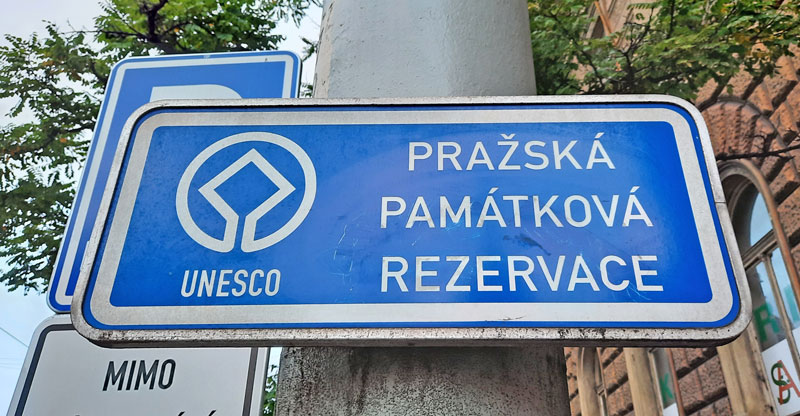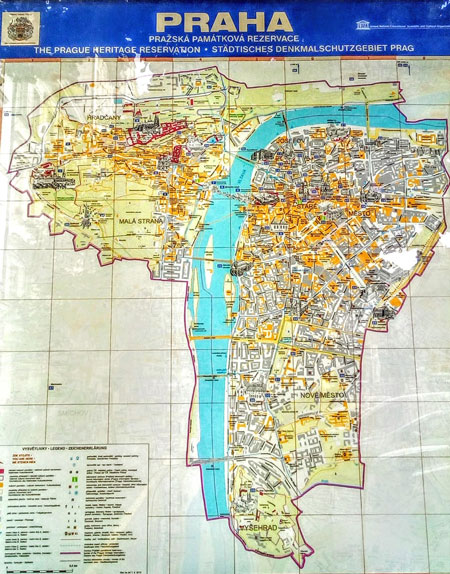Prague UNESCO
There are signs in the city like the one pictured that say you are entering the Prague Monument Reserve and hence, 95% of what a regular tourist would visit is in this area. As an old historic city you might expect several Prague UNESCO sites but you might not know that during the 16th UNESCO Session held in Santa Fe, New Mexico, USA, 7th-14th December 1992, the entire Historic Centre of Prague was inscribed onto the World Heritage List as number 616. Let’s take a look at how this area came to be defined and some statistics that you may not have known.

Outstanding Universal Value
UNESCO, the United Nations Educational, Scientific and Cultural Organisation considers potential sites against these three words “Outstanding, Universal and Value”. As far as making it to being inscribed on the World Heritage list, to be of Outstanding and most importantly Universal value means meeting strict criteria. Many European capitals struggle to get individual buildings listed. The Prague UNESCO Decision Summary references at least 4 different criteria for including Prague in the World Heritage List including authentic architecture, urban development, culture and religion. To quote from the report Prague “represents one of the most prominent world centres of creative life in the field of urbanism and architecture across generations, human mentality and beliefs”. In UNESCO’s 1992 decision they included the entire historic centre of the city and there’s a good reason for that.
What is the Historic Centre of Prague?
If you did one of my Walking Tours then at some point it will come up that back at the beginning of the reign of Emperor Josef II, Prague was geographically one walled city but administratively it was made up of the 4 towns called the Old Town, New Town, Lesser Town and Castle plus the fortified complex called Vyšehrad. Josef II basically joined the 4 towns into one administrative area. In 1922 these 4 towns (plus Josefov) became called Prague 1. This is what is largely known as the historic centre of Prague although the official boundary includes the Vyšehrad complex area of Prague 2. You can see the boundary of the historic area below.

In this map the Castle and Lesser Town is the fortified area to the top left of the river bend whilst the Old Town and New Town are on the right of the river. The New Town fortifications extended to Vysehrad at the base of the picture centre-right. On the left side of the river you can see the border line running along the riverside. This was not originally enclosed by fortifications but was included in the Prague Monument Reserve and hence, was included in the Prague UNESCO decision.
The Prague Monument Reserve
In 1958 the Czechoslovak Federal Assembly created the framework to be able to establish City Monument Reserves largely aimed at protecting historically walled cities and towns. In Prague we had to wait until 1971 before the Prague Monument Reserve was created in the area inside the old fortifications. Czechs refer to it as the PPR (Pražská Památková Reservace). The Prague UNESCO part covers an area of 8.66 square kilometres but there is a surrounding area called the Protective Zone which is a further 89 square kilometres and UNESCO calls this the “Buffer” zone. A problem in Prague at present is development of buildings on the horizon (what UNESCO calls the “roof line”) that may adversely affect the historic cityscape.
Interesting Facts
The City of Prague manages ALL Prague UNESCO sites with the exception of Prague Castle which is managed by the Office of the President.
The Prague UNESCO historic area is 1.74% of Prague’s administrative area.
1322 buildings in the Prague Monument Reserve have “Listed” status with additional national protection.
60% of Listed buildings in the Prague Historic area UNESCO World Heritage List are at least 100 years old but 8% were built since 1945.
